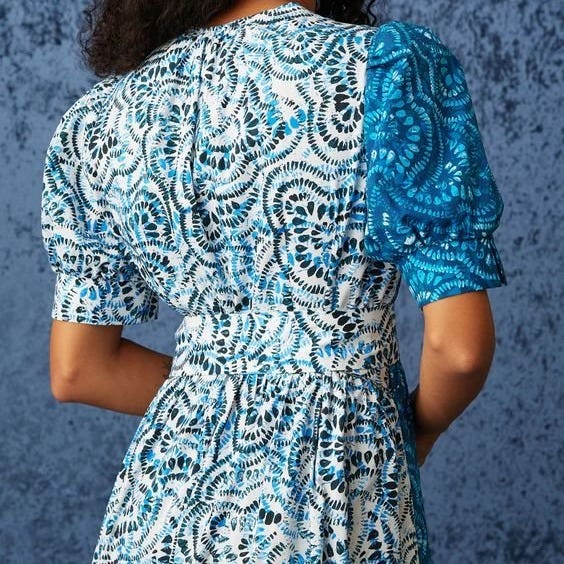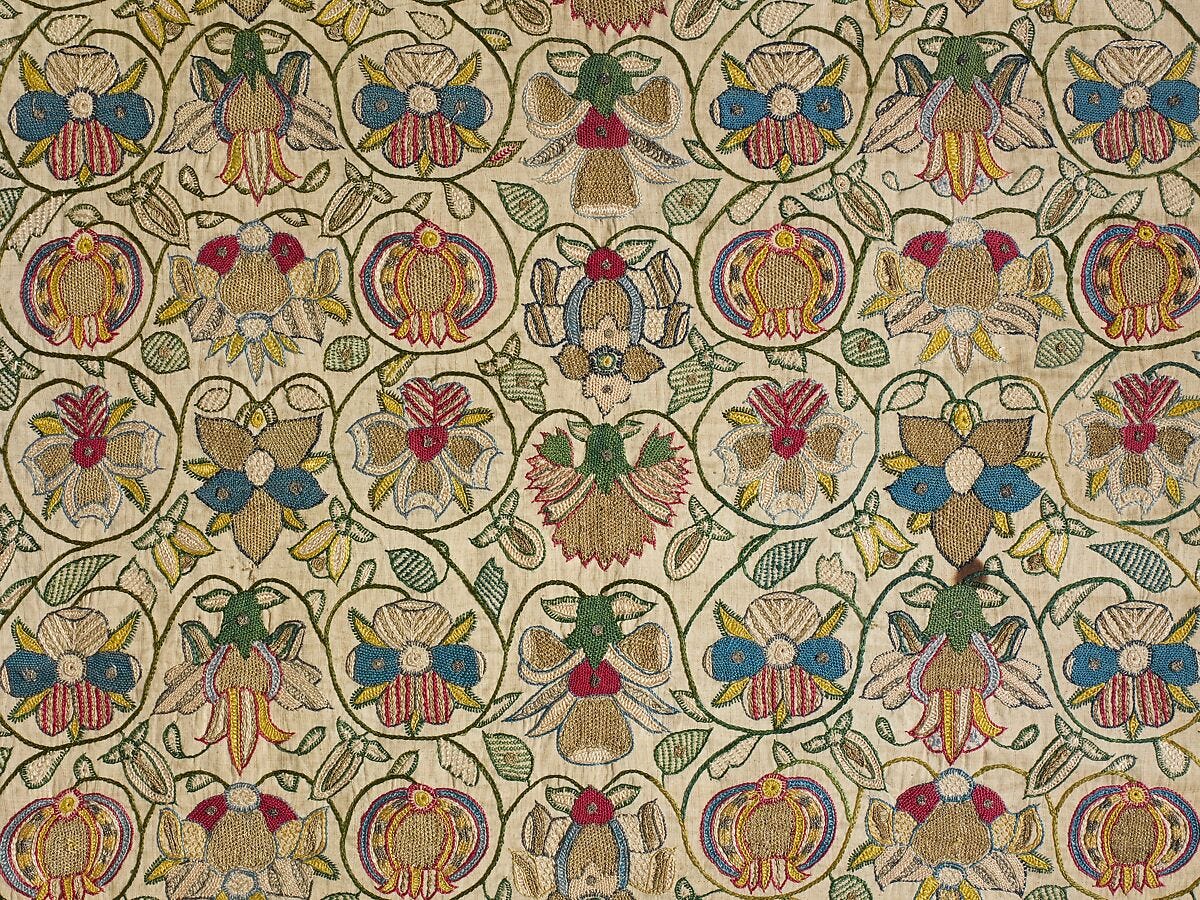On AI in Textiles
Should AI be used in textile design?
In May, one of my favorite textile news sources, Pattern Observer, polled their audience about our collective experience with AI. In their email about the survey, they asked, “Artificial Intelligence is changing the world around us, but how is it really being used by [textile] professionals like you? What opportunities and challenges do you see?” I was excited to submit my responses.
Most questions were straightforward about how the textile industry is adapting and reacting to the use of AI in our workflow, like “Overall, do you think AI is a positive force in textile design?” with checked responses, like “Yes,” “No,” or “It depends” for this question (I checked “No”). But in one of the final questions, they asked, “Any additional thoughts, experiences, or hopes about AI in textile design?” Here is what I wrote:
“I think AI is a great threat to textile design. In an industry that is so intertwined with handmade processes, both in the creative design and in the actual applications, AI has no place here. In the same way that the industrial loom created a significant devaluation of the textile industry and its workers in the 19th century and onwards, AI has the power (and already proven capacity) to completely replace and devalue the artist and designer for this generation. The efficiency and generative advantages of AI are attractive, especially in a speed-driven industry, but will ultimately be its downfall if fully integrated into the system.”
I was excited to hear from like-minded designers in the textile industry, expecting most of them to come to similar conclusions. Yet, the results were remarkably different. A whopping “73.3% of textile designers are currently using AI tools in their work.” They found 40.7% of the responders use AI for marketing and writing, 25.3% for both design and marketing, and only 7.3% use AI exclusively for design and art creation. I couldn’t believe how high those numbers were. Now I see how naive I had been.
The growth and wide adaptation of AI is not without reason. The demands on creative professionals is so high these days. I feel it as a fiber artist and textile designer and have seen the demands only grow exponentially over the past decade of my work in our increasingly digital world. To become a successful artist and designer, an active, daily presence is required on multiple social media outlets, marketing is of primary importance, and brand identity is key. Often, artists and designers spend the majority of their time marketing their work through many demanding channels, plus manage the backend requirements that go into running a business like bookkeeping, invoicing, and website upkeep. Only a small section of their time is in the actual creation of their work. With so much free access to marketing channels and media outlets, small businesses and designers have been led to believe that we can do almost everything in-house. Yet, our time is so spread thin and our budgets are so low, that we feel trapped in a system that relies almost exclusively on algorithms and luck to get the success we see in our feeds.
These high demands with little control over their ROI’s could be the factors that led designers to the point of desperation that we see in the results from the Pattern Observer survey. Most designers wrote that they utilize AI in marketing, social media, and writing tasks so that they can focus on the primary purpose of their business: creating textile designs.
Surprisingly, yet reassuringly, the survey also showed that corporate buyers are now often explicitly requesting art made without AI. There is a high demand for designs that have clearly been made by hand rather than the “artificialness” of AI-generated art. That shows that the greatest demand is for the handmade. The market is clear, if designers want to serve their buyers and customers today, the more authentic, the better.

Yet, many reported that they use AI in their brand messaging. To build a successful brand based on said handmade designs, every channel leading the customer to the designs should reflect the person (the hand) behind the designs. Using AI to speak about the hand behind the brand through marketing copy, social media posts, and general brand output is antithetical. It actually breaks down the design in the end. We cannot equate AI with the handmade, ever. The two are split between very different goals. One is for efficiency beyond human capacity and the other is slow, real, and distinctively human. I want to underline that generative AI (when AI is used in a creative endeavor) is the issue at hand. Logistical or mechanical applications (as in, please have AI schedule all of my family’s doctor appointments and request referrals for me) are a completely different ballgame than creative media. Even if AI “helps the marketing go faster so I can create art the old fashioned way,” it comes at an exacting price.
After all, Dr. Ian Malcolm said it best:
In an essay entitled “Comment” from American Craft magazine in 1985, John Bentley Mays wrote,
“It should be noted here that Modern art’s peculiar dislike to the hand - along with Modern criticism’s avoidance of crafts - is a heritage of this beginning. The pioneers of Modernism were enchanted by the breathtaking changes in economic and civil society wrought by industrialization. The machine, not the hand, would become the emblem of these transformations, as the artists sought to create an art equal in power to the machine, and to the tonic, exciting dislocations of industrial culture; they were moved by skepticism and science, not by old-fashioned pieties.”
We are in the midst of history repeating here. The industrialization and mass manufacturing of textiles of the modern era has led us to the problematic textile industry as we see it today. Textiles are the second-largest polluter in today’s environment and are a major culprit for unfair, unsafe, and unethical labor practices across the world, often taking advantage of the poorest and most marginalized in societies. The problem of today’s textiles is a case for a separate article, but the fact remains that textiles today are often disregarded in mass culture while being churned out at the fastest rates our world has ever seen.
The Pattern Observer survey showed 25.3% of users used AI for design and marketing and 7.3% were already using AI exclusively to create textile designs and artwork. If we, artists, create “art equal in power to the machine” again, the churning speed of this mess is going to increase exponentially until we reach a bubble-point where the whole industry is going down. When AI can be trained on past textile designs and create new patterns at an unprecedented rate, why would Shein or Temu bother hiring a textile designer at all? In a world where fast fashion reigns, the design and manufacturing of clothing will reach an even faster speed with almost no human involvement. Pattern Observer concluded that it is wise to use AI in external areas of business practice. Yet, if the number of designers using AI to create artworks grows, which I am sure they will, the workers (both designers and makers) will be even more undervalued, underpaid, and overworked, and the resulting designs are going to become more and more bland, standardized, and meaningless.

As my friend Sam Kelley has said, “If you are completely and utterly unique and you have been made in the image and likeness of God then that means you - in how you look, in your hopes and dreams and desires - you reveal something about God that nobody else does ever has or ever will again.” The designer’s personal touch likewise reveals something unique that no one else, not even AI, ever can.
Seeing that AI is being used in design by more than 30% of survey responders is concerning. After centuries of stripping away all meaning from the visual language in textiles, it’s only natural that we’ve landed at using AI in textile design. Yet, textiles are inherently and distinctly human and that should be at the core of why we make them. When I was a print designer at Lilly Pulitzer, I learned that the greatest value in print design is that it was made by a person. Lilly has an entire in-house creative team solely dedicated to print design from start to finish. To proclaim the hand through our artwork, we intentionally kept the imperfections: the wobbly lines, the overlaid colors, the natural blobbiness from painting with watercolors and acrylics. This is a practice I’ve continued throughout all of my work, creating every print by hand first (like in the print for Marie Oliver below) and this lesson was one of the greatest gifts I received during my time there.

I don’t know what the future will hold for textile design. It seems like the industry is becoming less split between two extremes: the Shein/Temu camp who are churning out textiles at the fastest, cheapest way possible vs. the slow/sustainable fashion camp who are attempting to be more meaningful in their textile creation. As the industry moves forward with AI, it is becoming harder for the latter to hold onto their integrity and keep up with the pace of the former. The demand for handmade, authentic artwork remains in a growing segment of our society, but how is it sustained in a speed-driven industry? I firmly believe that if more people knew about the problems behind today’s mass textile manufacturing, the less we’d feed this broken system. Let’s hold on to what’s real and honor the hand behind the designs and the making of the textiles in our lives today. Maybe we can keep turning the tide.





